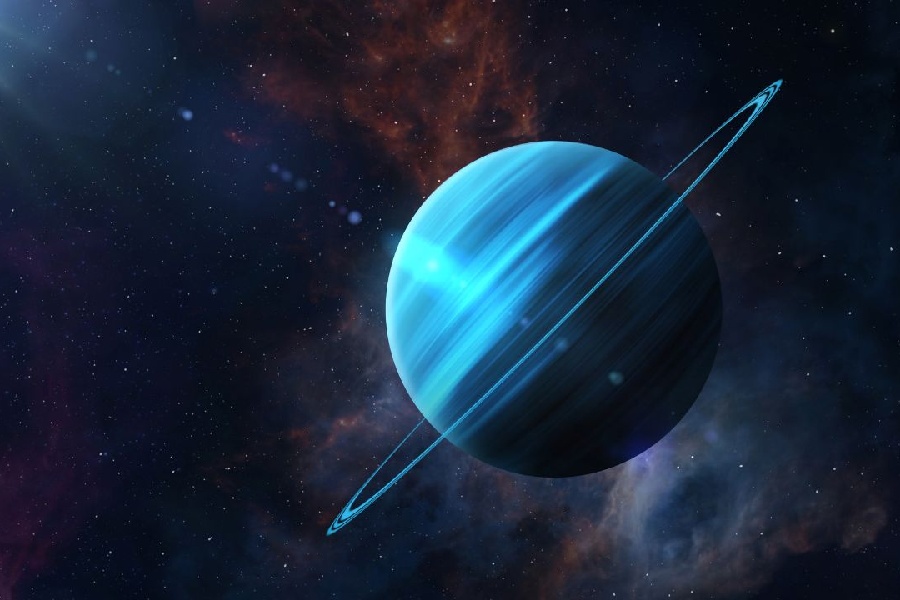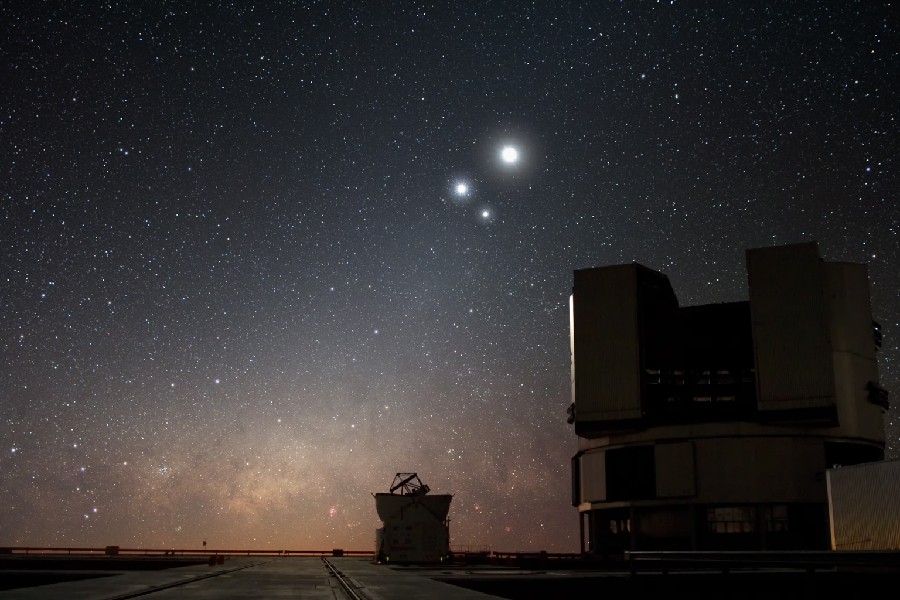Gazing up at the night sky, discerning eyes can spot the bright gas giants Jupiter and Saturn even without a telescope. But what about the icy outer planet Uranus, which lies farther from the Sun? Can you see Uranus without a telescope, just as you could see Jupiter?
Though not as readily visible, Uranus has been known since ancient times. In this article, we discuss Uranus’ key attributes, like brightness and apparent size, and how they impact visibility. Additionally, we will share tips for locating Uranus with binoculars or your unaided vision.
You’ll learn optimal conditions and techniques to spot elusive Uranus amidst the ocean of background stars. So join us on this starry quest to find out if Uranus is visible without specialized equipment.

Can You See Uranus Without a Telescope?
Yes, Uranus is visible to the naked eye under pristine dark sky conditions, but it is extremely faint. It shines at the threshold of human visual perception with an apparent magnitude of +5.7.
It appears as a tiny, dim blue-green dot, often indistinguishable from background stars. While technically visible without optical aids, using binoculars can dramatically enhance the view.
A moderate backyard telescope with at least 100x magnification will reveal it as a small but distinct aquamarine disc. Successful observation is contingent on minimal light pollution and accurately targeting its location relative to star patterns.
Visibility of Uranus From Earth’s Surface
General visibility challenges
Spotting distant Uranus poses inherent visual challenges from the Earth’s surface. Uranus orbits very far from Earth. It is over 2.5 billion kilometers away from our planet. So, is Uranus visible to the human eye?
Even though Uranus is large in size, it appears faint and dim from Earth. Its vast distance makes Uranus very hard to see. So far, the remote ice giant is barely moving among constellations, so it’s difficult to distinguish it from background stars.
Optimal viewing conditions and techniques
Discerning hard-to-spot Uranus is possible but requires excellent viewing conditions. The sky quality is crucial – observers need a crystal clear, cloudless night without artificial light pollution from cities to maximize visibility.
It also helps to be familiar with Uranus’ passage by distinct nearby stars and accurate star charts to scan its specific celestial locale patiently. Certain best practices make pinpointing evasive Uranus more feasible under clement skies.
One technique is scrutinizing any faint blue star-like objects and then comparing them to nearby star patterns. Unlike stars, Uranus exhibits a subtle aquamarine glow, allowing it to stand out.
Timing-wise, the visibility window for Uranus is narrow, optimally positioned highest around midnight into the pre-dawn sky. During this short time span, Uranus aligns favorably for naked eye spotting potential against the stellar backdrop expanse.
Where to Look for the Planet in the Night Sky
Uranus passes through the constellations Cetus, Aries, and Pisces following its orbit. Amateur astronomers can target Uranus using surrounding star patterns. Its position near the star Torcular provides a guidepost for scanning with optics.
Accurate sky charts tracking Uranus’ changing position among stars and patterns aid identification. Consult recent charts, noting their expected coordinates before gazing upward. Methodically scan along that zone to recognize Uranus based on context from the charts.
Smartphone apps like SkyView provide real-time augmented reality overlays of constellations. Input your location and phone orientation, and the app details what celestial bodies are currently overhead. You can confirm where to expect hard-to-spot Uranus on your screen and compare it to the actual night sky.

Choosing an Optimal Time to View the Planet
The best visibility times fall in the late night into early morning hours when Uranus reaches maximum altitude and is positioned due south, favoring northern views. The midnight to the pre-dawn window provides peak brightness.
Uranus visibility changes along its 84-year orbit as distances/angles to Earth vary, with some seasons like equinox offering enhanced vantage points. Attempting annual sightings when Uranus is nearer on its elongated path can improve naked-eye odds.
Pairing Uranus’ brightest midnight-to-dawn arc with ideal atmospheric conditions greatly boosts sighting success. Dark, clear, moonless skies during Uranus’ highest passage present the best opportunity to spot the planet in the night.
Consulting optimal calendars multiples the chance of finally glimpsing elusive Uranus. But what if unaided vision fails to reveal Uranus? Can you see Uranus with binoculars? Let’s find out.
Using Binoculars or a Small Telescope
Under non-ideal conditions, binoculars or a small portable telescope can be useful. They help resolve Uranus from a faint blur. These optical aids magnify Uranus enough to discern its tiny disk against background stars. Aided optics gather more light to see detail.
Accurately sighting Uranus relies on steadily pointing optics at its celestial coordinates as Uranus slowly drifts. Mounting binoculars or a tracking telescope provides a stable aiming platform over just manual handling.
High-end digital tracking mounts paired with cameras enable automated Go-To targeting and exposure photographing of Uranus. Though expensive, digital mounts automate pointing corrections, freeing the user to concentrate on image captures.
Knowing What Color to Look For
Uranus exhibits a distinctly icy blue-greenish color. This color is unlike the surrounding stars that are viewable to the naked eye or a telescope. The blue-green hue results from methane gas in Uranus’ cold upper atmosphere. This gas preferentially absorbs red wavelengths of light, similar to our blue Earth, with its ocean and oxygen-rich air.
Expecting a subtle blue-green orb helps correctly spot elusive Uranus against the dark canvas of space. Do this by consciously comparing the colors of spotted points of light when scanning the expected coordinates of Uranus.
Stars shine white or reddish; meanwhile, distant Uranus displays a noticeable frosty cyan glow to keen inspection. Its tinted face standing apart from stellar neighbors aids recognition, confirming the sought sighting of the ice giant instead of just another far sun.
Long exposure photographs amplify Uranus’ aquamarine coloration over real-time observation. This is especially useful for assessing marginal visual sightings. Capturing time-lapse images can prove a naked-eye glimpse.
The images resolve Uranus’ disc next to false-colored stars. This categorically confirms the brief sighting. It does so through compounding time. Such photos freeze the discovery for commemorative review.
The Impact of Light Pollution on Viewing Uranus
Light pollution from urban and suburban lighting brightens the night sky. It obscures dim objects like faint distant Uranus. This makes it challenging to spot Uranus with the naked eye or binoculars. Excessive glare washes out its struggling starlight.
To mitigate light pollution, experienced observers travel to darker rural sites preserving natural nightscape conditions. Getting away from city light trespass improves already slim odds of glimpsing stealthy Uranus unassisted.
Cloudy and humid conditions also diminish prospects by amplifying bright skyglow in populated areas. Checking forecasts allows smartly timing searches for clear, dry nights when the atmosphere scatters less interfering light. This further aids in extracting elusive Uranus from washed-out obscurity.
Conclusion
As our investigation comes to an end, we hope this conveyed the naked-eye viewing prospects to discern the icy giant Uranus. Though tiny and remote, under ideal skies, even amateurs have a chance to glimpse elusive Uranus without optics.
By outlining the best techniques, timing, and location guidance, this article aimed to maximize the odds of spotting Uranus. In addition to the outlined recommendations, we included comparisons of Uranus’ faint glow next to nearby stars.
Providing all this information, we have answered the question about Uranus visibility. So, can you see Uranus without a telescope? If, one clear night, you catch an unexpected blue orb, it may be the icy Uranus.
